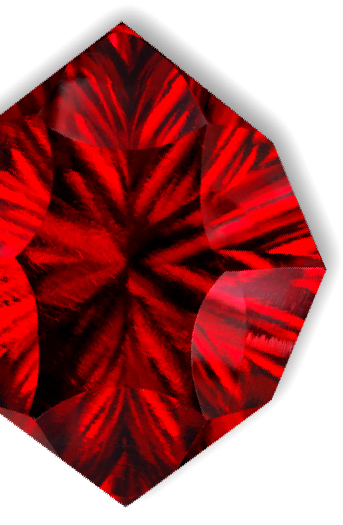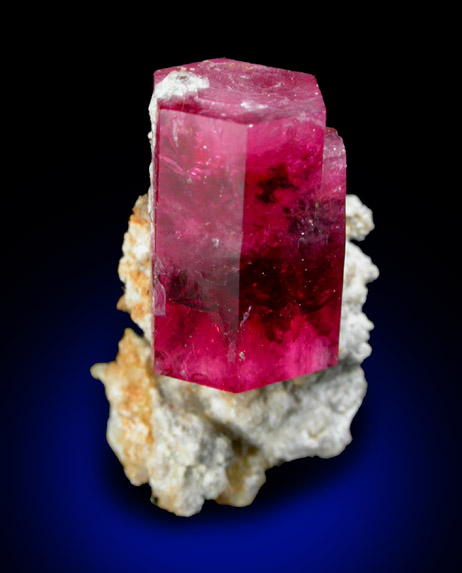
Red Beryl (Bixbite) (also known as “red emerald”, “scarlet emerald”) is a red variety of Beryl.
Red beryl or bixbite was first described in 1904 based on a discovery at Maynard’s Claim in the Thomas Mountains in western Utah, USA. It was named after Maynard Bixby (1853-1935), an American mineralogist.
The colour is predominantly red of various tints: strawberry, bright ruby, cherry, and sometimes orange. The colour is stable up to 1000°C.
Red Beryl occurs as hexagonal crystals which is typical of beryls. The refractive index is 1.564-1.574 and the specific gravity is 2.66-2.70. It’s primary chemical composition is Be3Al2SiO3, but there are traces of many other elements.
The crystals are often small, average weight of cut material is 0.1 to 0.4 carats, but may reach several carats.
Red Beryl is the rarest form of beryl, which includes emeralds and aquamarines. The only crystals suitable for faceting were found in the Wah Wah Mountains (the Violet Claims now understood to be closed) near Beaver, Utah. Currently, this area is the only place in the world where gem quality Red Beryl was found. The red beryl from the Thomas Range are also extremely rare, and can still be found with some back breaking hard rock mining and lots of luck. The Thomas Range crystals from Juab County Utah, although generally opaque and tabular, are still wonderful specimens,
The gem is marketed as “red emerald,” and touts it as one of the rarest gemstones in the world. Prices run as high as $10,000 a carat for top specimens. Most red beryl specimens are under a carat. A 2 to 3 carat stone would be considered very large.
BUYER BE AWARE of what’s being offered on the market!! Not all red beryl is the same.
Natural crystals come only from Utah , either the Wah Wah mountains or the Thomas Range.
“Pressure treated” red beryl has recently shown up for sale and this treatment is not being properly disclosed. I have seen natural red beryl for sale that is filled with a resin, oil or plastic who knows what! This is done to improve the clarity, and thus increase the price being asked by the seller. The filler can boil out when the stone is heated or when cleaned ultrasonically. Gems with this treatment should be disclosed as a “filled” gem. This is NOT a permanent treatment and the stone can be changed back to the original lower clarity grade. This may also subject the stone to further damage. Recently, (2013) I’ve also noticed statements saying that some oil is absorbed during the cutting process and there may be some present in the finished gem, etc. That’s very suspicious in my book! If the stone is really a low grade, fractured and beat up specimen, I suppose it could be possible, but if that’s the case it isn’t going to carry a high price. Beware of such nebulous caveats!
Lab grown crystals are genuine red beryl crystals that have been grown in a modern laboratory process. They are not some other mineral that has been treated, heated or filled or faked (simulated) to look like bixbite. They are genuine red beryl with the same physical properties of mined crystals. These are the lab grown crystals that I personally facet. If I could find or afford comparable mined crystals that’s what I would cut; they simply are not available and the majority of those that are cut are not pretty. So like most fine artists, I want to paint on the best canvas that’s available — in this case it’s the lab crystals!
Pezzoittaite from Madagascar is similar in appearance, but is not bixbite. It has a different refractive index, as well as different density and specific gravity. Some of the red gems being sold in the market as red beryl or bixbite are actually Pezzottaite, a new gem variety discovered in Madagascar. Pezzottaite is also very rare — but not yet as valuable as bixbite — but is a different mineral altogether, with a different chemical composition, density and refractive index. A new find of pezzottaite in Afghanistan has made this new gemstone more widely available. Red beryl is so rare that it is wise to always insist on certification from a recognized gemological lab when buying this gemstone.
Aquamarine can be heated and diffusion treated which means a small number of manganese atoms transfer to the aquamarine in a thin film which changes the color to red. It is NOT Bixbite.
In general step back and look at what your buying. As with all collectibles, deals that seem too good to be true, probably are!

